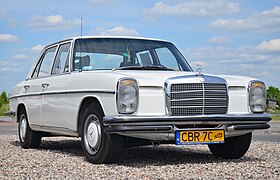Mercedes-Benz W114
| Mercedes-Benz W114/W115 | |
|---|---|

1973 Mercedes-Benz 220D
|
|
| Overview | |
| Manufacturer | Mercedes-Benz |
| Production | 1968–1976 1,919,056 built Saloon: 1,852,008 Coupé: 67,048 |
| Assembly |
|
| Designer | Paul Bracq |
| Body and chassis | |
| Class | Mid-size luxury / Executive car (E) |
| Body style | 4-door sedan 2-door coupé 4-door limousine |
| Layout | FR layout |
| Related | Mercedes-Benz W116 |
| Powertrain | |
| Engine | |
| Dimensions | |
| Wheelbase | 108.3 in (2,750 mm) 133.9 in (3,400 mm) (limousine) |
| Length | 184.3 in (4,680 mm) 195.5 in (4,970 mm) (US bumpers) 209.8 in (5,330 mm) (limousine) |
| Width | 69.75 in (1,772 mm) |
| Height | 56.75 in (1,441 mm) |
| Chronology | |
| Predecessor | Mercedes-Benz W110 |
| Successor | Mercedes-Benz W123 |
The Mercedes-Benz W114 and W115 models are a series of sedans and coupés introduced in 1968 by Mercedes-Benz, manufactured through model year 1976, and distinguished in the marketplace by names relating to their engine size.
W114 models featured six-cylinder engines and were marketed as the 230, 250, and 280, while W115 models featured four-cylinder engines and were marketed as the 200, 220, 230, and 240.
All were styled by Paul Bracq, featuring a three-box design. At the time Mercedes marketed sedans in two size classes, with the W114/W115 positioned below the Mercedes-Benz S-Class.
Beginning in 1968, Mercedes marketed their model range as New Generation Models, giving their ID plates the designation '/8' (due to their 1968 Launch year). Because they were the only truly new cars of the so-called 'New Generation' and because of the '/8' or 'slash eight' designation, W114 and W115 models ultimately received the German nickname Strich Acht, loosely translated into the English stroke eight.
The W114/W115 models were the first post-war Mercedes-Benz production car to use a newly engineered chassis, not derived from preceding models. The new chassis format of semi-trailing rear arms and ball-joint front end first displayed in the W114/W115 chassis would be used in all new Mercedes passenger car models until the development of the multi-link rear suspensions of the 1980s. The W108/109 S-Class chassis of the 280S/8, 280SE/8 and 300SEL/8 (and W113 280SL Pagoda) would be the last of the low-pivot swing axle and king pin/double wishbone front ends. The next S-Class -the W116 chassis- having the same engineering of the W114/115.
The W114/W115 models replaced the W110 Fintail models stemming from 1961, and were themselves replaced by the W123 series after 1976.
The Mercedes-Benz W114/W115 was the mid-sized saloon model for Mercedes, positioned below the S-Class. Mercedes also launched its first 5-cylinder diesel engine OM617 in this chassis. It followed heavily in the direction set by the W108/109 S-class, which was launched in 1965 and heralded the new design idiom. The car was designed by French auto designer Paul Bracq who was chief designer at Mercedes-Benz for models from 1957 to 1967, a period that included models such as the Grosser Mercedes-Benz 600. Bracq was also responsible for BMW designs (1970–74) and Peugeot designs (1974–96).
...
Wikipedia
